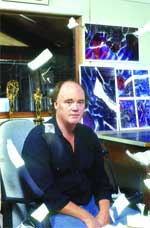Despite, or perhaps because of current economic forces, it seems that California is becoming even more of an epicenter for feature film visual effects. Each of our Visual Effects SWOT respondents focus on the need for a large high-tech infrastructure and staff to handle the intense demands of large scale film work.

John Knoll Visual Effects Supervisor ILM www.ilm.com San Rafael, CA
|
Perhaps the most dramatic example of these forces at work is Robin Shenfield's decision to close Oscar-winner Mill Film (in favor of the Mill's commercials division). Conversely, the dip in ad dollars forced ILM closed its commercials division earlier this year.
STRENGTHS: Work that a few years ago was very difficult and demanding has been made a bit easier and cheaper now by better software and faster computers. Yesterday's cutting edge effect you can now do with an off-the-shelf package.
WEAKNESSES: There's been a slowdown in the number of big effects pictures that have gone into production, so the competition's been a little difficult over the last year. I'm not sure how much further that's going to go before the economy recovers. We've seen some of our vendors having a difficult time, too - it's been sort of difficult for the people who supply us with their tools to continue to be profitable.
OPPORTUNITIES: There are great opportunities out there for garage operations. The bar has been lowered so much by having very powerful, inexpensive desktop computers and very sophisticated software packages that it's practical now for somebody working out of their garage to be doing quality visual effects. I've seen a lot of places that cater to little niche markets, just [working] out of their apartments. [Regarding "invisible" effects] in Star Wars there are plenty of places where George [Lucas] likes to do these sort of editorial things where he changes the sync on one actor's performance, or we reframe a shot afterwards or take out an eye blink. But I don't think that's really an "opportunity" for us, because what we try to focus on is that bolder shot. What George has maintained for years is that that's an extension of editorial. All that sort of work should be right in the Avid room or adjacent next door.
THREATS: Competition from others who are willing to take a loss to get work, that's always been a difficult issue for us to deal with; you have to stay profitable. The other difficult thing for us is we're always at the mercy of whoever happens to be deciding to greenlight projects or not, so there may be a period coming up where there's a backlash against the giant, $120 million movies - so we're at the mercy of outside forces. And the effect that September 11 had on the advertising industry as a whole put our commercial division out of business. So once the economy picks up, that may become a viable business for us again, but it isn't now.

Phil Tippett Founder Tippett Studio www.tippetstudio.com Berkeley, CA
|
John Knoll was one of ILM's three main visual effects supervisors on Star Wars Episode 2: Attack of the Clones.
STRENGTHS: Visual effects have seen a great deal of this change, allowing it to be really out in front. There are some good things and bad things that have come along with that; the greatest strength is it's actually allowed us to see into the future of cinema a bit.
WEAKNESSES: The switch to digital! There was quite a serious schism between the practitioners of CGI and [experienced] filmmakers. Sometimes, to a lesser degree now, you'd find people without production experience. Discipline is gained by working with a more experienced person.
Another weakness overall is how other producers and directors understand visual effects. Now we have a lot of visual effects supervisors or visual effects producers hired by production who really don't trust the visual effects company to deliver the work.
OPPORTUNITIES: There are always opportunities for skilled and committed people. Many schools are training kids to create reels. We get hundreds of these three-to-four-minute reels and you can tell immediately if somebody has the skill.
The market is somewhat flooded. But now there are huge companies making $300 million movies that are huge commitments that take three or four years to put together, so the opportunities there are pretty secure.
In the past 20 years, the 10 top movies are all visual effects pictures and to the degree that [audiences] don't burn out on that material, I suppose the future's bright. But you never know.
THREATS: A great number of movies that come out using visual effects haven't been very well written. One of the main things that cinema has to offer, above any other form, is spectacle. But most times, it's the result of marketing and business decisions, and the resulting scripts and filmmaking process is such that they're no good. But they can still be sold and can still make a great deal of money. Another thing is other governments are subsidizing their motion picture industries and the threat of work going offshore is a very real one. Also, because of the expense and because schedules are so tight, production and post have been squashed together so you don't have any time to plan, which is the main thing. Pre-planning is one of the tremendous assets of very strong filmmakers. [When] there's no planning and you're just completely in reactive mode and budget overruns occur and the studios get angry and everybody's yelling at each other, it's just the last thing in the world that you want in a creative milieu.

Robin Shenfield CEO The Mill www.mill.co.uk London
|
Phil Tippett has worked in the industry for 30 years; he produced the visual effects for Starship Troopers and is directing the sequel.
STRENGTHS: Visual effects are becoming a bigger cog in a huge machine, but it's still a small piece, however critical those shots are. We can't always choose the projects we take on but we do always try and take on pieces of work that drive you to a new place that's exciting; that gets you to develop some new skill or technique. What turns people on in this industry is the work! Whether it's commercials or film, it's the opportunity to participate in a rich piece of visual media. We're creative businesses in the true sense - the people that we hopefully develop, encourage and inspire, occasionally, are really motivated.
WEAKNESSES: Lack of anticipation. The creative business is full of optimists who think things are going to go to plan. It's an immensely hard business to be in, and that's exacerbated by the uneven flow of work. You're keenly aware, on a business level, that you're offshore from the US; you're subject to a business that's changing its shape all the time that's 6,000 miles away. The [American] movie business in the UK is here largely to exploit tax breaks. Production ran away to the UK, to Europe, to Australia, to New Zealand. Visual effects has now run away, too. If you want to do that work then you have to be a certain type of business with scale, investment and infrastructure. A weakness of the UK is that, individually, the businesses are too small in a global scale to do the work that the bigger and better companies in the US can do.
OPPORTUNITIES: There's a two-way flow of talent and know-how and techniques between film and commercial effects, particularly between compositors and CGI people. One of the benefits our commercials business has seen from our involvement in film is it's kind of honed our CGI skills - it's taught us how to do projects in a more efficient way.
THREATS: The business threat in the UK is all about lack of continuity of business. Our focus is almost exclusively to America. The level of indigenous production of films this year is half what it was when Mill Film opened in 1997. And small movies don't have the budget to support the scale of investment required to do the kind of work that we're all interested in doing. Clearly, the work is getting more and more demanding. The work is creatively very challenging and incredibly complex in its execution. It requires a lot of smart people to work out smart ways to write cloth, natural phenomena, character animation, or to put more and more vast amounts of data and layers and rendering through your pipeline so that the work doesn't become uneconomic.

Tim Sarnoff President Sony Pictures Imageworks www.imageworks.com Culver City, CA
|
The Mill won the Oscar for Gladiator, but shortly after this interview, The Mill decided to leave the film business and focus on spots.
STRENGTHS: We are seeing more skilled talent every year. We can do more now than ever before and our appetite for challenge remains unsated. The beautiful part of this business is that people in it are always looking to the future; we welcome change. More important, though, is focus. The industry has a better focus on what it can do well and where its efforts are most needed.
WEAKNESSES: The weakness of the industry still remains "over-promising" both to the producers and the public. For producers, the desire to get the most on the screen for the least amount of money can negatively impact the quality of the effect. Quite often, cheaper and better do not go hand in hand. Pressure is always placed on this industry to do more with less and sometimes, for those who [promise] too much, producers will get less for less. We routinely look three to five years in advance and then speculate about the technology that will be needed. The risk there is huge. This is where a company's commitment and depth of bench become critical.
OPPORTUNITIES: This year has proven that large, character-driven films make large sums of money. Studios need large hits, not small hits. At Imageworks we are continuing our forward march toward digital character animation with our current projects and our pending projects from Sony Pictures Animation. That is the real opportunity. The opportunity for smaller companies, since some have been able to redefine themselves toward a specific focus, is to be able to dominate in specific service areas not controlled by the larger studios.
THREATS: Poorly crafted stories will have a greater negative impact on the visual effects industry than anything we in this industry can control from within.
Imageworks supplied the visual effects for Spider-Man and are currently working on Spider-Man II.